Homeschooling high school doesn’t have to be difficult! Even with the added paperwork and academic recordkeeping, with a few templates in hand, you’ll be making an awesome transcript in no time. Here’s what you need to know to make a homeschool transcript.
Be sure to grab the free student grade sheet in this post along with a link to a free transcript template.
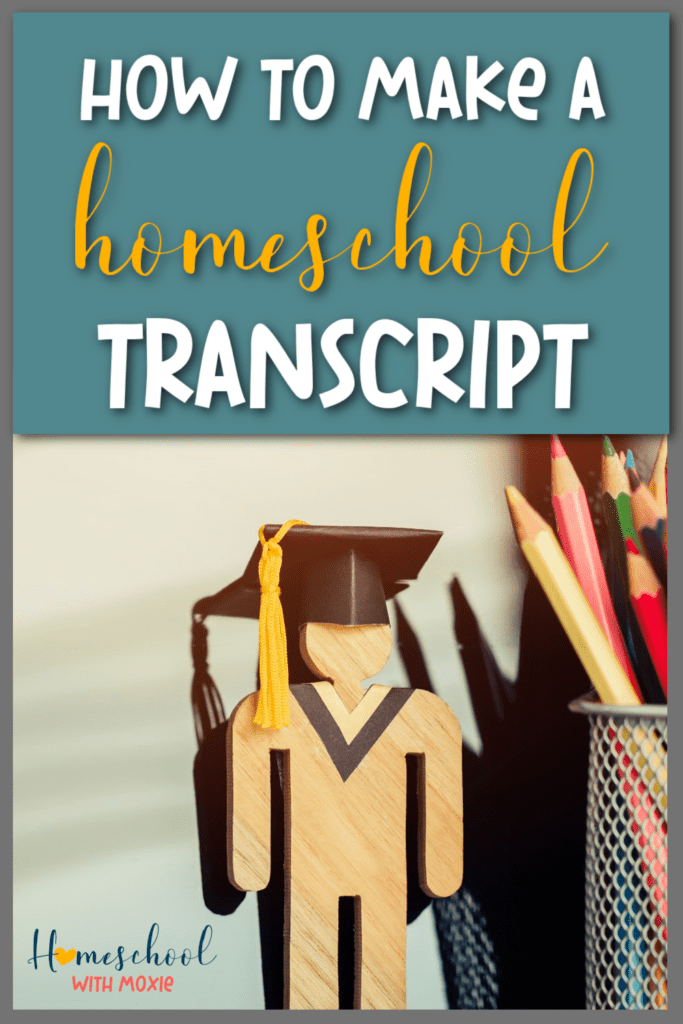
This post contains affiliate links for your convenience.
Transitioning to High School
Homeschooling K-8th can be a lovely journey filled with passion projects, lots of hands-on experiences, and a general plan of study. You want your kids to be exposed to lots of great content and learning experiences, but the main goal is to raise kids who love to learn.
We don’t even keep grades in K-8. Unless your state requires them, there’s really no need. Do your children understand the lesson? Great, then you can move on. If they haven’t reached mastery, then work on the material again. This is a relaxed homeschool philosophy in the younger grades, especially for core subjects like math and language arts. The kids really do need to work toward mastery at ever increasing levels. In other words, focus on the tools of learning.
However, for the other subjects, including science, social studies, fine arts, Bible, foreign language, and more, your homeschooling will be focused on exposing them to the good, true, and beautiful. You’ll be reading a lot and engaging the kids with hands-on activities. You probably won’t want to be bogged down with piles of worksheets. (In fact, I don’t recommend it!)
Then something changes when we reach ninth grade.
When we hit the high school years as homeschool moms, we can tend to get mighty nervous mighty fast. Instead of a gentle approach to learning, we’re told we need to figure out GPA’s and keep a transcript! You don’t need to feel overwhelmed with the advent of high school paperwork. Let’s break down the steps and see how you can easily make a homeschool transcript.
Philosophy of Education at the High School Level
Before we get to transcripts in detail, let’s discuss broad goals for homeschooling at the high school level.
Before your child begins 9th grade, you’ll want to have a general plan for the future.
Is college a possibility? Then plan on college-prep classes.
Is your child headed into a hands-on field and profession that doesn’t require a college degree? Then plan on internships and apprenticeships in his chosen field.
Double check the graduation requirements in your state. HSLDA maintains state-by-state information. You don’t want to be caught during your child’s senior year trying to frantically fit in all the courses so she can graduate on time!
Even though you may have state requirements to fulfill, homeschooling high school can still be a customizable journey. You have the flexibility to cater to your child’s interests and passions, hobbies and talents.
Does your child excel at sports and is possibly looking at a scholarship to college pertaining to his sport? Then craft his high school years around his goals.
Do you have a musically gifted child that intends to pursue this further after graduating? Then you have the freedom to let her devote many hours per day to practice.
If your child is a tech whiz, or wants to grow in this area, then pursue opportunities, apprenticeships or entrepreneurial endeavors that fit those passions.
If K-8 was for growing a foundation of love of learning, then 9-12 is for digging deeper into areas of interest while still having a well-rounded finish. In any walk of life, communication, innovation, and collaboration skills are going to be key in the 21st century. So do all you can to help your high schooler grow in these areas.
So once you have a general idea of the future path your high schooler may take, you should sketch out a 9-12 curriculum plan with names of courses and curriculum you might use.
You can find curriculum planning sheets plus scheduling helps in our FREE Homeschool Schedule Planning Pages.
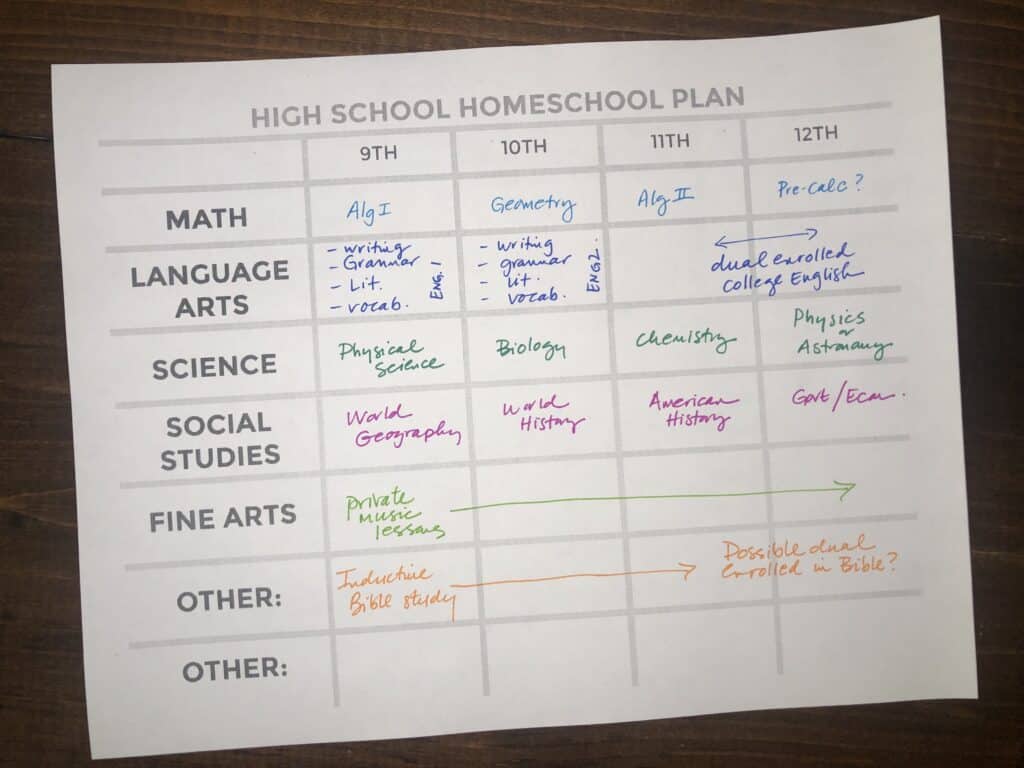
Choosing Courses in High School
You’re not bound to keep with this original plan. But it will give you a working document to check back on as you plan each year.
As you plan the high school coursework, remember that your role as a homeschool parent will continue to change. And also remember that you do not have to teach everything – or anything! There are so many rigorous online high school classes for homeschooled students in the core classes along with elective options.
Your teen should be very independent in their homeschooling by the high school years. Your role as the parent will be more of a mentor, coach, and cheerleader. You will help craft the high school coursework requirements, find the resources, enroll your child in the classes and be there to answer questions and help along the way. But a maturing high school homeschooler will be learning to manage his time well and taking responsibility for his own education.
Here’s a graphic that shows the relationship between the parent and child through the homeschool years. Notice how as the child’s independence grows, the parent’s role also changes.
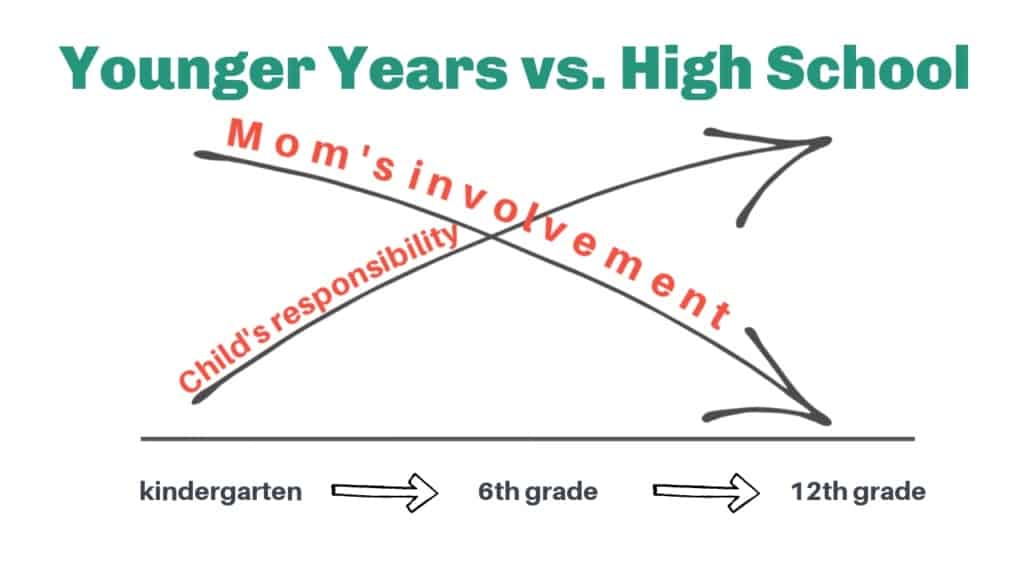
Curious about some of our high school curriculum selections? Here are our favorite curriculum companies for high school courses plus reviews of our experience with using them.
MATH
CTC Math – We used a traditional textbook approach for some of our kids all the way through 12th grade. But once I had several kids doing middle and high school math, I just didn’t have the time (or patience!) to help them through the tough lessons. So, I realized that it was worth it to invest in a family membership with CTC Math. You have access to all their courses for as many kids as you need.
Thinkwell Homeschool Math – Thinkwell was another great online option for high school. We didn’t love the format as much as CTC Math, so we didn’t stick with it after Algebra I. But some of you may like Thinkwell better, so take a look!
BJU Press Math – BJU Press is a very traditional textbook approach, which may work for some of you. We definitely use their math from K-8, then started switching over to online options. But they also have online courses where the teacher will teach the material to your student, and that may work well for some of you. It’s a more traditional approach that the first two online math resources I linked to above.
SCIENCE
CrossWired Science – If you want a very flexible, enjoyable online science program you can use with the whole family, then you may want to look into CrossWired.
Super-charged Science – The e-Science Homeschool Science Curriculum allows you to dive into the content via topics or grade levels. You could use this one program for all your homeschooled kids in grades K-12. While we used it with our elementary student, this hands-on program has options for all grade levels.
Chemistry 101 – When our dyslexic student reached high school, we knew we couldn’t keep using the curriculum we had used before (Apologia). He needed something more visual and easy to follow. We used Chemistry 101 videos in conjunction with Friendly Chemistry.
Friendly Chemistry – This curriculum was much easier for our dyslexic student to understand. We utilized their video lessons in addition to the student book and teacher book.
Apologia Biology & Physical Science – We still do use Apologia science courses in high school. When our kids need a bit of help, we switch over for a chapter or two to Friendly Chemistry or Friendly Biology along with the Chemistry 101 or Biology 101 videos. Being able to pull from all these wonderful resources has helped us in the high school sciences! This post gives a peek into our first year using the Apologia Biology & Physical Science in high school.
LANGUAGE ARTS
Institute for Excellence in Writing – IEW has excellent resources for teaching your students in the language arts. Their Fix It! Grammar helps students learn and review grammar concepts in context. While our review is a peek into the younger years with their curriculum, they do have Fix It! Grammar resources for 9th-12th grade. IEW’s Structure and Style Level C course will take your high schoolers on a 24 week writing intensive. IEW also offers paper-based writing, grammar, and literary analysis courses as well. Our middle schooler used IEW Ancient History-Based Writing Lessons and after seeing the approach, I can highly recommend their writing lessons for high schoolers, including Advanced U.S. History-Based Writing Lessons and Bible-based Writing Lessons.
Easy Grammar Systems – Here’s an easy-to-use grammar component for your English elective that only requires 5-10 minutes a day to learn and review grammar concepts.
College-Ready Writing Essentials – This online course teaches research-based persuasive academic writing (college prep!) in 25 easy lessons.
BJU Press English 10 + 11 – BJU Press curriculum is very traditional. It’s written for a Christian school classroom, so you will need the teacher’s book, if only for the answer keys. While it might not work for everyone, we used it to get a solid grammar review in during high school. These high school English courses from BJU Press include a very rigorous grammar education plus writing component. We opted to just focus on the grammar sections.
Vocabulary Virtuoso PSAT-SAT – Here’s a great resource to add to your high schooler’s language arts courses as they prep for the SAT. It only requires a few minutes each day.
Writing with Skill – While WWS is technically a middle school writing curriculum, if your student doesn’t have a good foundation of writing skills yet, I think you could still use this in the early high school years. This curriculum is written for the homeschool market, so it’s easy to follow. Your students will learn to outline, write science and history essays and papers, and they will learn to include works cited, footnotes, and other methods of documenting their research. You might want to start with WWS 3 for your high schooler. You can read author Susan Wise Bauer’s recommendations here.
SOCIAL STUDIES
Notgrass Exploring World History – Notgrass History is very user friendly. Some of our high schoolers have done their world history credit by taking a world history college course. That way, they are able to start earning college credits in high school as dual enrolled students. But for some, they opted to use Notgrass instead.
We’ve also used Notgrass World History and American History. They’ve just released a World Geography course which I wish we would have had about five years ago! But we’ll be purchasing that soon for our next rising 9th grader.
Economics for Everybody – This includes a DVD and study guide from Compass Classroom. It was a great choice for my dyslexic student as it wasn’t textbook or reading-heavy and very enjoyable. We used this as a ½ credit. If you want to expand the economics into a full credit, Compass Classroom has an Economics Homeschool Set that includes Basic Economics.
Constitutional Literacy – My teens have a good grasp on basic government concepts as we talk politics all the time in our home! So one teen in particular wanted to deep dive into Constitutional Literacy by Michael Farris. Apologia sells the workbook and DVD set.
FOREIGN LANGUAGE
Visual Latin – We’ve used Compass Classroom’s Visual Latin for one high schooler in our homeschool and it comes highly recommended by us! But Compass Classroom has more elective options for you as well. These include filmmaking, logic, economics, and more.
TalkBox.Mom – The beauty of this foreign language membership is that you can use it with all your kids! But you can also be confident that your high schooler will be fluent in the language by the time you’re done.
ELECTIVES
The great part about electives is that your student can pursue studies that will help them stand out from their peers. When you homeschool, you even have the freedom to incorporate internships and apprenticeships on the transcript. Here are some ideas for elective courses in the high school years.
SchoolhouseTeachers.com Ultimate Annual Yearly Membership – This membership is listed under electives because they do offer dozens of options! But a SchoolhouseTeachers.com membership would also give you access to every course your high schooler would need. So, if you’d rather not pick and choose from multiple curriculum companies to craft your high school plan, just grab a yearly membership and choose your online courses from their huge catalog.
Inductive Bible Study Courses – While many Christian students will have learned the basic chronology of the Bible and the basic Bible stories, they are ready to deep dive into the text of Scripture by the time they hit high school, if not earlier! If you feel intimidated with teaching them how to study the Bible, then Inductive Bible Study Courses will help. Your teens can study independently through entire books of the Bible using the Self Study Workbook, or add in the Video lessons component for your visual learners. If you want an online Bible course, then you’ll love the Gospel of John Online Course. Use the code INDUCTIVE20 to save 20% off any Bible resources.
Creating a Masterpiece – Drawing Program for Homeschool – This online program can be used by all ages for wonderful results.
CLEP & DSST Prep Materials from Study.com – If your students want to earn college credits through CLEP and DSST exams, then here are prep materials that will help.
Stopmotion Animation Kit – Here’s a fun resource that you could use to create an interesting elective for your high schooler.
Victus Study Skills System – Do your teens know how to study and manage their time? This system will help.
Code for Teens – Coding is a sought-after skill in today’s economy. This book will walk your student through learning how to code. It’s easy to use and could count as an elective on their transcript.
Selling on Etsy Masterclass for Teens – Your creative teens will learn multiple life skills in entrepreneurship, business, customer service, and more when they set up an Etsy shop and sell their handmade items. This is a great platform for handmade, vintage resellers, and digital creators.
Podcast Launch for Teens – Instead of a traditional speech elective, why not encourage your entrepreneurial teen to launch a podcast instead? They will learn most of the skills taught in a speech class plus additional skills needed for the podcasting medium.
Think outside the box for your homeschool high school electives!
Here are a few more helpful links:
11th Grade Homeschool Curriculum Picks – This is just a peek into one of our 11th grade years and the curriculum that worked for that child at that time.
Can I Really Homeschool High School? – When you feel overwhelmed at the thought of homeschooling high school, here’s a dose of reality for you. Yes, yes you can homeschool high school.
Ultimate YouTube Playlist for World Geography – Years ago when we couldn’t find a high school geography curriculum that worked well for us, I created this huge list of YouTube videos for all the geographic regions. The videos explored not only physical geography, but political issues, culture, human interaction, and more. Use this playlist alongside your geography curriculum or create your own course with a geography encyclopedia as the spine.
Ultimate YouTube Playlist for High School Physical Science – Once again, this list was created out of necessity! We were using a dry textbook for physical science and it wasn’t great. So in an effort to spice things up (my kids really needed some visuals), I created this YouTube video playlist to go along with the topics in their physical science book. You can use these links alongside of most physical science curriculum.
10th grade Homeschool Curriculum Plan – Here’s a peek into one of our 10th grade years and the resources we used.
9 Benefits to Homeschooling High School – If you’re on the fence about homeschooling high school, consider these benefits!
Apologia Science Curriculum Review – One year we switched up our science curriculum and jumped all the way in with Apologia. Here’s an overview of the courses we used that year, including Physical Science and Biology in high school.
Keeping Track of Grades
Most states will require some sort of transcript for your homeschooled high schooler. In order to produce a transcript, you need to keep track of grades earned in 9th through 12th (or high school level courses taken before 9th grade). Please see my post about Tracking Progress in your homeschool.
If you remember to keep a running total of points earned throughout the school year, you won’t have a hard time filling out the course names and GPA each semester or end of year.
Download a free student grade sheet
Here’s what we do. My high schoolers have 3-ring notebooks with dividers for each course they are taking. In each course section, they have a grade sheet.
As they complete assignments, tests, or quizzes that are graded, they keep the paper in the notebook, but also record the points earned and the total points. That way, at any point in the year, we can divide the total points earned by the total points available and know their percentage grade in the course.
How to calculate GPA
At the end of the semester or year, this percentage grade is translated into a GPA for the transcript.
Here is a scale from the CollegeBoard for converting your child’s percentages to GPA.
So on a daily basis, your high schooler will keep track of his grades on a grade sheet in a 3-ring notebook. At the semester or year end, you will transfer the final GPA and course name onto the transcript that you are keeping for him for 9th-12th. I don’t worry about being neat as we go. I just hand write things onto a blank transcript form, and know that when my kids graduate, I will neatly type out their “official” transcript.
Let’s talk about what needs to be included on your homeschool transcript.
Basic Sections of a Transcript
Courses
For each year of high school, you should list the courses taken. Use clear names that show that graduation requirements have been met. For example, if your state requires four credits of English, then call that course English.
Don’t forget to include extracurriculars as well. It will show your student has had a well-rounded education. If your child takes dual credit courses through a community college, do include those as well.
One credit typically refers to a year-long course. So if your child studied geometry daily for the whole school year, this would be one credit. Adjust accordingly. If they had art class one day per week and also worked on their art another day or two of the week, that would correspond to about .5 credit. Or, if they completed a course every day for one semester, that would also count for .5 credit.
If you’re piecing together a high school English course, for example, while including some grammar review, literary analysis, and writing, you can simply name it English 1, English 2, etc. Or you could name them English 9, English 10, etc.
Grades
Keep track of grades all year long and you won’t be scrambling at the end to assign a letter grade to your student. Use the GPA table above to convert percentages to numbers on a four point GPA scale.
Additional Information
Don’t neglect to list special awards or activities your child earns. Also include volunteer activities and other accomplishments.
Homeschool Transcript Template
Here is a simple and editable PDF of a transcript. Click on the image and it will take you to the blog which has this PDF.
You can also see and print out sample transcripts and blank transcripts from the HSLDA website HERE.
Homeschool Transcript Sample
Here’s how your high school transcript might look. You’ll want to make sure all the student information and school information is completely filled in. Also notice that a transcript is only one page. You want an easy to follow academic overview.
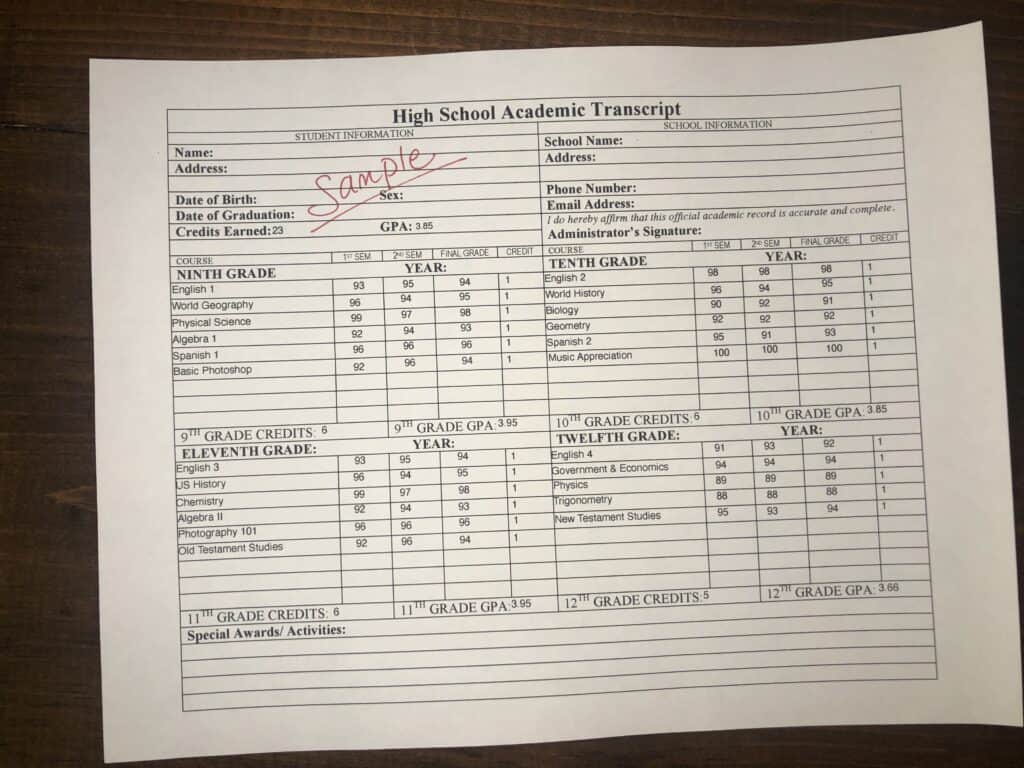
This particular transcript shows each year of high school separately. Another option would be to group courses according to academic discipline. This is more helpful if your student took longer than normal to complete a course.
I’ve done homeschool consulting with families who needed a Subject Transcript instead of a yearly transcript. If your state requires a certain amount of credits in each academic category, then this subject transcript might work better for you.
Find additional resources for homeschooling high school in our FREE members-only resource library.



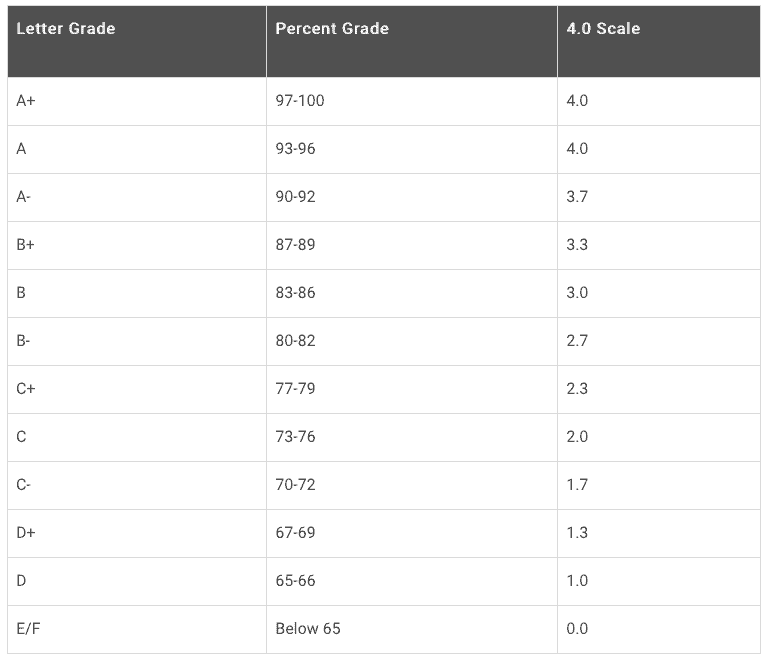
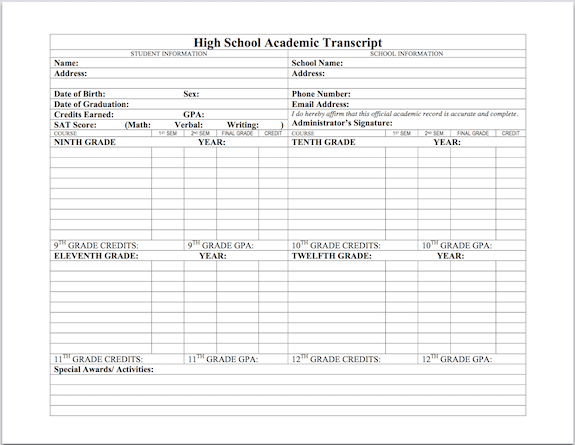

Hello! Thank you for all the helpful information on your site. I apologize if the answer to my question is in the reading. I’ve been on countless sites trying to see how different families use Constitutional Literacy. I am also a teacher turned homeschool mom! What grade did you use this in? Did you use it over one semester (2 lessons a week, .5 credit)? Or the whole school year? I have the book and dvd’s already and have watched some of it and I just can’t decide what to do. I have a 10th grader who has just discovered that he really enjoys politics and government. He has taken US History from the new world through current events. Have a great day!
Hi Melissa! My senior is using Constitutional Literacy this year. My original plan was to fit in as much as we could over one semester, but he wanted to keep going, so it will be a full credit for the year. He watches the DVDs, reads the book, and then completes one of the questions at the end of the lesson that asks for analysis and application of the content. Personally, I’m having a hard time figuring out how to assign a grade for this course, as it doesn’t include tests or quizzes. It looks like it includes 25 main lessons. So, if your child finished sooner, you could always include some free course content regarding the constitution from Hillsdale.edu. Since it’s our first time using it, I might change up our plan with the next kid. We’ll see! Hope this helps!